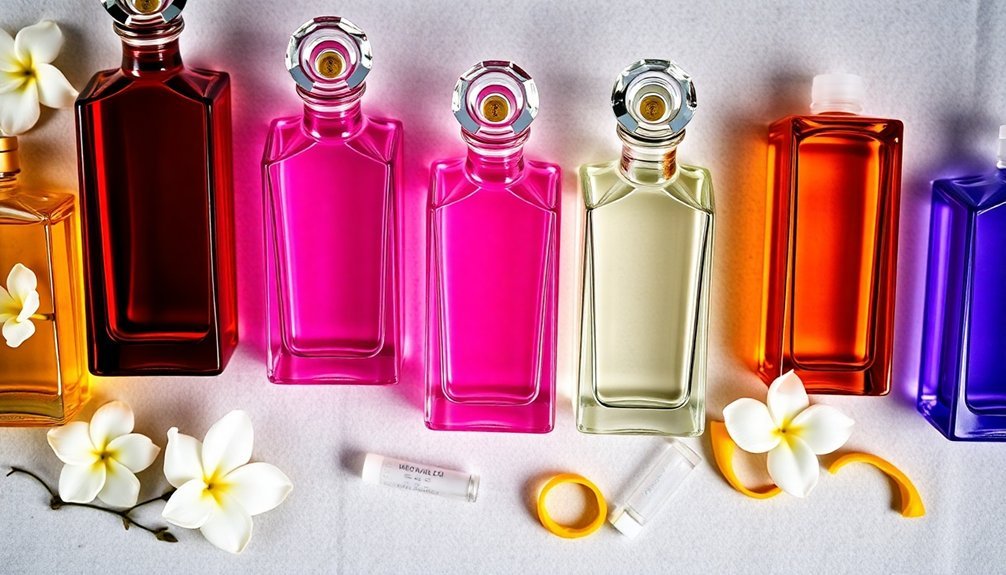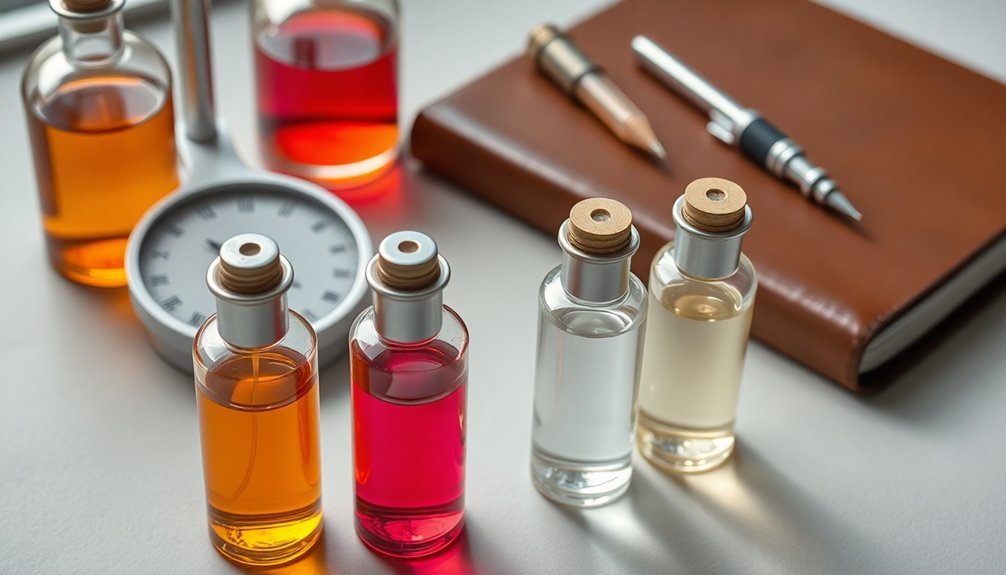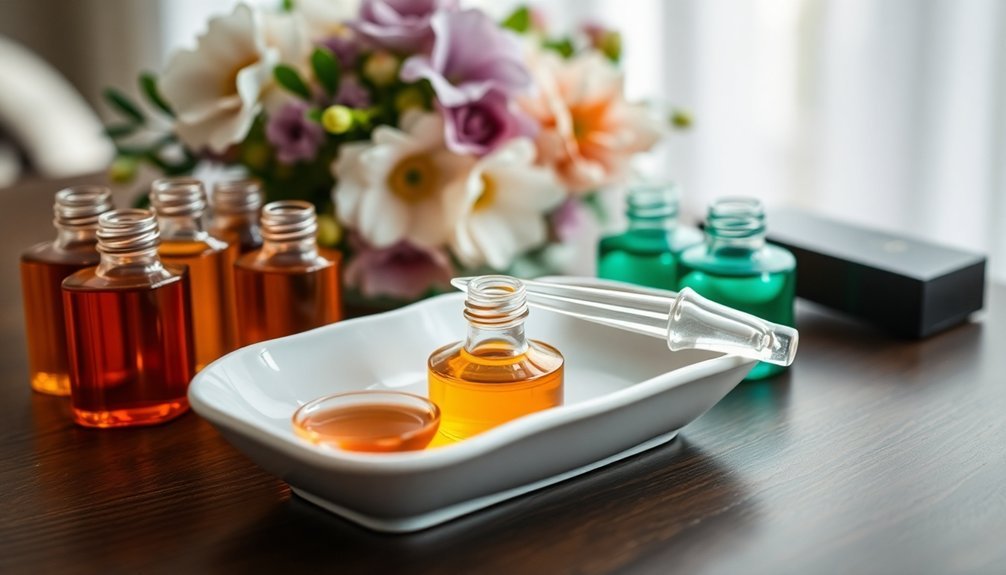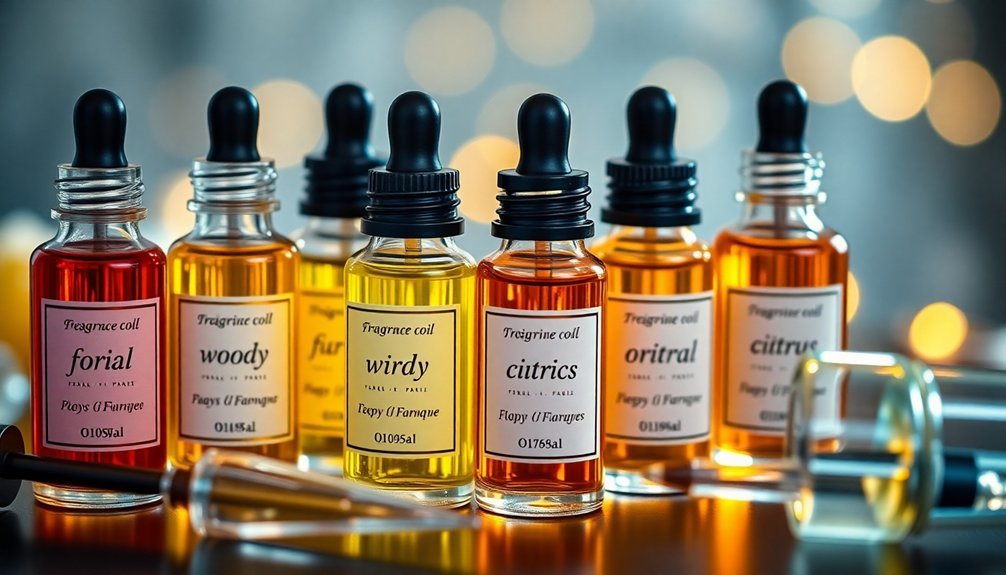Perfume fragrance ratios vary based on the type of scent you're creating. For pure parfum, use 20-30% fragrance oils with your base, while Eau de Parfum needs 15-20%, and Eau de Toilette requires 5-15%. The remaining percentage should be your carrier base (alcohol, oil, or water). You'll want to measure precisely using a digital scale for accuracy, not drops. Proper dilution guarantees your scent's safety and longevity – just the beginning of crafting professional-quality fragrances.
Understanding Basic Perfume Concentration Levels

Four main concentration levels define the strength and longevity of perfumes: Parfum, Eau de Parfum (EDP), Eau de Toilette (EDT), and Eau de Cologne (EDC).
Parfum contains the highest concentration at 20-30% fragrance oil, lasting up to 24 hours and offering intense, luxurious scents. The mixture of pure oil concentrates typically contains between 30 to 60 different raw materials.
EDP follows with 15-20% concentration, providing 4-6 hours of balanced fragrance that's perfect for daily wear.
You'll find EDT lighter, with 5-15% fragrance oil lasting 3-5 hours, making it ideal for daytime use.
EDC and Eau Fraîche represent the lightest options.
EDC contains 2-4% fragrance oil, lasting about 2 hours, while Eau Fraîche has just 1-3% concentration for a quick refresh.
Both are excellent choices for sensitive skin or when you're seeking a subtle scent.
Essential Tools for Measuring Fragrance Ratios
After understanding perfume concentration levels, you'll need the right tools to create your own fragrances.
Start with a digital scale that measures to 0.01g precision and gather essential glass equipment like beakers and pipettes for accurate mixing and dispensing.
Don't skip safety gear – you'll want gloves, protective eyewear, and masks when handling concentrated oils.
Keep your workspace organized with proper labels and storage solutions for your ingredients.
You'll need perfumer's alcohol or carrier oils for dilution, plus blending tools like coffee filters and mixing implements.
Track everything meticulously using notebooks or digital spreadsheets, and always check IFRA restrictions for safety compliance.
Store your blends in a cool, dark place to mature, and use blending worksheets to maintain consistent formulations and measurements.
For optimal development of your fragrance blends, allow a minimum 48-hour maturation period before conducting any scent testing.
The Science Behind Fragrance-to-Base Calculations

To master perfume creation, you'll need precise measuring tools like graduated cylinders and digital scales that can detect minute differences in fragrance oils and bases.
Understanding base selection is critical, as each type (alcohol, oil, or water) affects your final concentration differently and requires specific dilution calculations. Proper maturation and aging helps the fragrance components blend harmoniously over several weeks.
You'll find success by following standard ratios – for example, creating an Eau de Parfum requires exactly 15ml of fragrance oils per 85ml of base, with careful attention to mixing speed and temperature.
Measuring Tools and Methods
Creating precise fragrance formulations requires accurate measurement tools and consistent methods. You'll need a digital scale that measures to 0.01g precision, as drops are unreliable due to varying liquid densities. When measuring, always use percentages rather than volume-based measurements for consistency and easy scaling.
| Tool/Method | Purpose | Benefit |
|---|---|---|
| Digital Scale | Precise weight measurement | Accuracy to 0.01g |
| Percentage Calculations | Formula standardization | Easy scaling |
| Spreadsheets | Safety compliance checks | IFRA verification |
| Databases | Material properties | Vapor pressure data |
| Safety Resources | Guidelines and limits | Regulatory compliance |
Your measurements must be exact when working with fragrances. Using a scale eliminates the variability of drops and guarantees your formulations are safe and repeatable. When calculating ratios, work in units of 100 or 10 to simplify your math and maintain precise control over your creations.
Base Selection Guidelines
Understanding the science behind fragrance-to-base calculations is essential for crafting successful perfumes.
You'll need to select a base that aligns with your market demands and skin considerations. Alcohol-based perfumes offer immediate impact and broad appeal, while oil or water-based options work better for sensitive skin.
Your base choice affects how fragrance notes interact and develop. Alcohol enhances top notes, making them more prominent initially. For ideal results, blend your middle notes at 50-75%, top notes at 20-40%, and base notes at 5-10% of the total composition.
Consider using high-quality fixatives to slow down evaporation and enhance longevity.
Remember that your base selection should reflect your brand identity and target market preferences while ensuring proper note structure and layer shifts.
Dilution Ratios Explained
The science of diluting fragrances requires precise calculations and careful measurements to achieve ideal results.
You'll need to understand weight-to-weight ratios, where common dilutions include 10% for most materials and 1% or less for potent ingredients like Ethyl Vanillin.
Key dilution ratios to remember:
- 10% dilution: 1 part fragrance to 9 parts diluant
- 5% dilution: 1 part fragrance to 19 parts diluant
- 1% dilution: 1 part fragrance to 99 parts diluant
When working with dilutions, you'll want to use a precise scale rather than counting drops.
Always mix your fragrance oils into the diluant slowly while stirring thoroughly. For best results, use perfumer's alcohol as your diluting agent, or DPG for oil-based perfumes. This guarantees proper solubility and stability in your final product.
Professional Methods for Scaling Perfume Formulas

When you're ready to scale your perfume formulas professionally, you'll need both dilution charts and precise weight measurements to maintain consistency.
Your dilution charts should clearly show the concentrations of essential oils and fragrances in different bases, while your weight measurements must account for specific gravity differences between ingredients.
Using a digital scale accurate to 0.01 grams will help you convert your small test batches into larger quantities without losing the original fragrance profile.
Dilution Charts For Beginners
Professional perfumers rely on three essential dilution charts to transform raw materials into wearable fragrances.
These charts help you calculate precise ratios of fragrant materials to alcohol, ensuring consistent results every time you create a perfume.
- EDT (Eau de Toilette) charts map out 10% dilutions, perfect for lighter, everyday fragrances.
- EDP (Eau de Parfum) charts guide you through 15-20% dilutions for medium-strength scents.
- Parfum charts detail 30% dilutions for creating intense, long-lasting fragrances.
You'll want to start with basic percentages like 1%, 2%, and 5% to practice your dilution skills.
Use pipettes for liquids and spatulas for solids, always documenting your work.
Remember to label your samples clearly and maintain consistent ratios across your formulations.
Accurate Weight-Based Measurements
Accurate measurements make or break a perfume formula, which is why leading perfumers rely exclusively on weight-based methods.
You'll need to abandon drop-counting and invest in a quality scale to achieve professional results. Start with a minimum batch size of 10 grams for your experiments.
To scale your formulas properly, you'll need to account for the specific gravity of each essential oil.
Multiply the weight of each ingredient by its specific gravity, then calculate its percentage of the total blend. These percentages become your master formula, allowing you to scale up or down with precision.
You can use these calculations to determine exact quantities for any batch size.
While small rounding errors may occur, they're negligible when you follow proper weight-based measurements.
Common Mistakes in Perfume Dilution Ratios
Creating the perfect perfume requires precise dilution ratios, yet many perfume makers stumble over common mistakes that can ruin their fragrances. You'll need to avoid these critical errors to achieve the ideal scent profile.
- Over-concentrating your fragrance oils can lead to overwhelming scents and skin irritation, while under-concentration results in weak, barely detectable perfumes.
- Using the wrong carrier oils, especially those with strong scents or non-polar properties like coconut oil, can interfere with your fragrance's intended profile.
- Measuring by drops instead of weight and failing to properly mix your ingredients will result in inconsistent ratios.
Remember to distinguish between essential and synthetic oils, as they require different dilution percentages. Essential oils need lower ratios (1-3%), while synthetic fragrances can handle higher concentrations (10-20%).
Always conduct patch tests to verify skin safety and store your diluted perfumes in dark glass containers.
Mastering the Art of Base Selection

When selecting a perfume base, you'll need to contemplate multiple factors that greatly impact your final fragrance's performance and appeal. Your choice will determine how your scent projects, its longevity, and its overall character.
| Base Type | Best For | Key Benefits |
|---|---|---|
| Alcohol | Broad Appeal | Enhanced top notes, immediate impact |
| Oil | Sensitive Skin | Long-lasting, gentle wear |
| Water | Gentle Formulas | Skin-friendly, subtle projection |
You'll want to match your base to your target market's preferences while considering skin sensitivity issues. For instance, if you're creating a mass-market fragrance, an alcohol base might be your best choice for its proven appeal and excellent projection. However, if you're targeting those with sensitive skin, you might opt for an oil base, which offers extended wear time and skin-nurturing properties.
Temperature and Storage Effects on Fragrance Ratios
Temperature and humidity dramatically influence how your fragrance performs, making it essential to understand their effects on scent ratios and storage conditions.
When it's hot, your perfume's top and middle notes become more prominent, but they'll evaporate faster. Cold weather brings out deeper base notes while slowing down evaporation, extending your fragrance's longevity.
- High humidity helps your scent last longer by slowing evaporation and maintaining intensity
- Hot conditions require lighter, citrusy fragrances while cold weather calls for rich, warm notes
- Proper storage prevents your fragrance ratios from becoming unbalanced over time
You'll want to adjust your fragrance selection seasonally and consider both temperature and humidity levels when choosing where to store your perfumes.
Creating Custom Strength Perfumes at Home

Before you begin mixing your custom-strength perfumes, you'll need essential measuring tools like graduated cylinders, pipettes, and precision scales to guarantee accurate ratios.
You'll want to protect yourself with safety equipment such as gloves and goggles, while also selecting appropriate dark glass bottles for storage away from light and heat.
Your base ingredients should start with high-quality carrier agents like perfumer's alcohol or jojoba oil, which will determine the final concentration and skin compatibility of your fragrance.
Essential Tools For Measuring
Creating custom-strength perfumes requires precise measurement tools to guarantee consistent and reliable results. You'll need digital scales with 0.01g precision to accurately weigh fragrance oils and confirm proper ratios in your blends.
Glass measuring equipment is essential, as plastic can react with oils and affect your formulations.
- Digital scales help calculate exact fragrance loads and minimize measurement errors
- Glass beakers, cylinders, and pipettes confirm precise dispensing of ingredients
- Conversion tools and calculators streamline the process of scaling recipes
Keep your measuring tools calibrated and maintain detailed records of your measurements in spreadsheets.
Using proper tools will help you create consistently balanced fragrances while saving time and reducing waste.
Remember that accuracy in measurement is vital for achieving professional-quality results in perfume making.
Safety And Storage Guidelines
When working with fragrance oils, proper safety protocols and storage methods are essential to protect both you and your perfume creations.
Always dilute your fragrance oils according to recommended ratios – typically 10-20% fragrance to carrier oil or alcohol. Don't rely on drops; instead, use a precise scale for measurements. Follow IFRA guidelines for safe concentration levels, which vary by product type.
For lotions, you'll need much lower concentrations than for soaps or bath products.
Store your fragrances in glass bottles in a cool, dark place to maintain their integrity. You'll want to label each mixture with its contents and creation date.
Choose your carrier agents carefully – oils are gentler for sensitive skin than alcohol. Keep all fragrance materials safely away from children and pets to prevent accidents.
Choosing Your Base Ingredients
To craft your perfect custom perfume, you'll need to understand how different base ingredients affect the final fragrance's strength and longevity. The key is selecting the right carrier agent and determining your desired fragrance concentration.
Most perfume oils require a carrier base of 80% and fragrance oils of 20% for best results.
- For a stronger, long-lasting scent, aim for a 20% fragrance concentration, similar to traditional perfume oils.
- If you prefer a lighter fragrance, consider an Eau de Toilette formula with 5-15% concentration.
- For the most delicate scent, follow Eau de Cologne ratios at 2-4% concentration.
Choose your carrier agent carefully – jojoba oil and sweet almond oil work well for oil-based perfumes, while denatured alcohol is ideal for traditional spray fragrances.
Remember that alcohol-based carriers may dry your skin more than oil-based options.
Adjusting Ratios for Different Fragrance Families

Each fragrance family requires specific dilution ratios to achieve its intended effect and longevity. You'll need to adjust your ratios based on the type of scent you're creating.
| Fragrance Family | Typical Dilution Ratio |
|---|---|
| Oriental | 15-30% (Parfum/EDP) |
| Woody | 10-25% (EDP/EDT) |
| Floral | 10-20% (EDP/EDT) |
| Fresh | 5-15% (EDT) |
| Water/Citrus | 5-10% (EDT) |
For long-lasting oriental scents with rich amber and vanilla notes, you'll want higher concentrations between 15-30%. Woody fragrances work best at 10-25%, letting cedarwood and sandalwood notes develop fully. Floral compositions need 10-20% dilution to balance their powdery and fresh-cut flower notes. Fresh and citrus scents require lighter concentrations of 5-15% to maintain their crisp, airy character.
Safety Guidelines for Perfume Concentration Mixing
Working with perfume concentrations requires strict safety protocols to protect both you and your workspace.
Always wear proper protective equipment, including a reusable respirator with organic vapor filters and chemical-resistant nitrile gloves. Make sure you're working in a well-ventilated area away from any ignition sources.
When handling concentrated fragrances, follow these essential safety measures:
- Never test fragrances directly – dilute a few drops in hot water
- Store all materials in sealed containers away from heat and children
- Keep first aid supplies nearby, including eyewash solution and clean water
If you experience any skin or eye contact, immediately wash the affected area with plenty of water.
For inhalation issues, move to fresh air and rest. Don't hesitate to seek medical attention if irritation persists.
Always check the safety data sheets for specific handling instructions.
Frequently Asked Questions
How Do Seasonal Temperature Changes Affect the Ideal Fragrance Concentration Ratios?
You'll need stronger concentrations in cold weather since scents evaporate slowly, while lighter formulas work better in summer's heat. Adjust your ratios seasonally to maintain ideal fragrance performance and longevity.
Can I Mix Different Perfume Concentrations to Create a Custom Strength?
Yes, you can mix different perfume concentrations to create custom strengths. Try layering lighter concentrations first, then add stronger ones. Just make sure you maintain balance and don't overpower the lighter scents.
Why Do Some Fragrances Smell Stronger Despite Having Identical Concentration Levels?
Your skin's pH, body chemistry, and environmental factors affect fragrance strength. Plus, ingredient combinations create unique interactions, while your personal sensitivity to scents and application method impact how strong a perfume smells.
Do Natural Vs Synthetic Fragrance Oils Require Different Dilution Ratios?
You'll use similar dilution ratios for both natural and synthetic fragrances, but synthetic oils are often more concentrated, so you may need less. Always check IFRA guidelines for specific maximum usage rates.
How Does Skin Chemistry Influence the Recommended Fragrance-To-Base Ratio?
Your skin type affects fragrance ratios: use higher dilutions (15-20%) for dry skin to enhance longevity, while oily skin works well with lower ratios (10-15%) since it naturally holds scents better.
In Summary
Now you've got the knowledge to create perfectly balanced fragrances at home, but remember: always start with conservative ratios and adjust gradually. You'll want to keep careful notes of your successful formulas and respect safety guidelines. Whether you're crafting a light eau fraiche or a concentrated perfume, stick to standard dilution tables, measure precisely, and store your creations properly. Your attention to proper ratios will make all the difference.





Leave a Reply